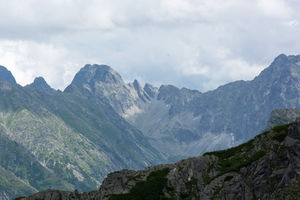Mountain tourism
| Mountain tourism |
|---|
| See also |
Mountain tourism involves many ways of hiking and wandering through rough and rocky terrain.
Main types of mountain tourism
Most common classes of this kind of tourism are:
- Independent mountain tourism: this type of travel is very popular among people who wish to reduce the financial costs. Tourist can create their own schedule, plan what to eat and where to sleep.
- Guided hiking - variety of mountain tourism, involving usually large group of novice travellers, conducted by a professional tour guide as established at the outset and accepted by all participants. Group accepts route planned by guide and follow him during trip. Guide makes sure that the group is not blown off-route. This mode of travelling is very expensive, but also provides a high level of comfort and even luxury.
- Hiking with children - planning a trip with a small child must by taken in advance (proper accommodation and food). Infant baby you can "take a walk" on parent in a special sling constructed on the basis of the backpack.
- Hiking with disabled people: if you intend to travel with a small group of elderly or people suffering from disabilities, you should learn about their diseases. Everyone should know the rules of first aid, and be equipped with a first aid kit containing the list of drugs that they should take in emergency.
- Advanced tourism: is something intermediate between exploring the mountain regions after labelled tourist paths and overcoming of routes, which the passage is only possible for persons having appropriate equipment and skills.
- Mountaineering - involves very difficult climbing trips with on high mountain terrain. Of all the above forms of mountain recreation it requires much experience and commitment. In order to overcome the difficult to reach parts of the mountains you must know how to use sophisticated climbing equipment.
- Cave tourism (spelunking) - trips to mountain caves, which have been made available for that purpose by national parks. It is not easy. The difficulties man encounters under the earth, arise from the specifics of the cave, where it is always dark, cool and humid. The underground corridors form a sometimes dense maze, where it's easy to get lost. Cave tourism require a higher degree of commitment and involves the use of techniques and equipment to reach places otherwise inaccessible.
Hiking trail
Hiking paths (trails) have a differentiated scale of difficulty, therefore, you should choose the one adequate for your experience. The degree of difficulty that you choose will decide the time necessary to overcome the distance. The time spent on traveling, also depends on the weather conditions and the actual physical fitness and mental well-being.
Preparation
Adequate preparation is necessary for mountain tourism. It requires planning of the various mountain hikes with an appropriate set of guides, maps, manuals, technical aids. Planning process involve: choosing goal, choice of hiking and walking trails, distinguishing the degree of difficulty of trails and tourist paths, preparing daily schedule on a mountain trail, appropriate selection of equipment and food supply. The amount of food depends on the length of the journey. One-day walk requires just a sandwich and a hot drink in a thermos. For several days journey you must obtain abundant food.
Equipment
Basic equipment, which should be in your backpack during any, even the easiest trips to the mountains, are: documents and money, watch, sunglasses, guide, first aid kit and a headlamp with spare battery. Expedition in the higher parts of the mountains requires a take compass and a precise topographic map of the region (or GPS device). Map, compass and altimeter helps to identify present location and the directions in which it should move to get to your destination. The higher we'll wander, we should choose more prudent set of clothes. It is necessary to warm clothes made of polyester material which has hydrophobic properties (fiber that hardly absorb water), even when they are entirely submerged. Soft shoes are only suitable for easy hiking trails leading a valley area. Rocky paths require more specialized footwear that provides good grip against the rock. Backpack should adhere closely to the body and does not wobble from side to side during the movement. Trails leading through hilltops or fragile rocks require the use of a helmet.
Dangers
Dangers in mountain tourism primarily are associated with the mountain climate. Fog, which often restricts visibility is one of the most dangerous enemies of the tourist. Fog is usually cold and damp, but the biggest danger is difficulty in orientation and all the consequences flowing from here. Wind is other serious danger, because unexpected gusts can knock off balance and push into the abyss, so in windy conditions, avoid routes leading on mountain ridges or ribs rock.
References
- Fredman, P. (2008). Determinants of visitor expenditures in mountain tourism. Tourism Economics, 14(2), 297-311.
- Nepal, S. K., & Chipeniuk, R. (2005). Mountain tourism: Toward a conceptual framework. Tourism Geographies, 7(3), 313-333.
